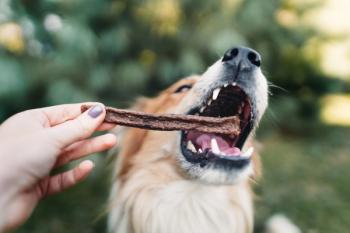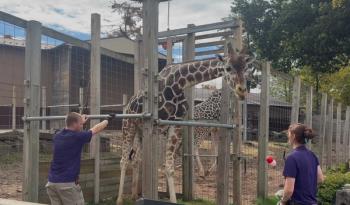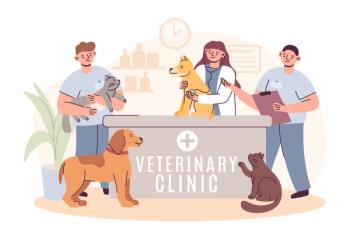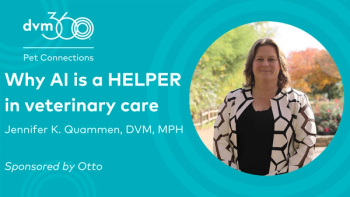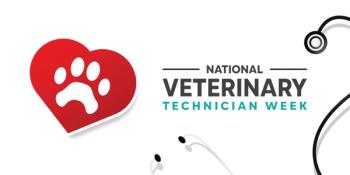
- May 2018
- Volume 3
- Issue 4
Legacy of Love: One Woman's Journey to Help Domestic Violence Victims
Lucy’s Project shines a light on a largely unaddressed—and often unrecognized—issue: animals affected by violence at home.
“I didn’t want [Lucy’s] life and death to be in vain, and I wanted to turn such tragedy into beauty,” Ludvik said. “I loved the idea that her beautiful name could shine a light on a relatively unheard-of issue—animals affected by domestic violence—and help protect other innocent animals, children, and women.”
As an animal advocate, Ludvik saw how poorly understood this aspect of domestic violence was, with no movement around it in her home country of Australia. “I found out quickly that ours is an ‘aha!’ cause,” she said. “As soon as people hear about it, it makes sense to them, and they get on board.”
RELATED:
- Helping Those Who Cannot Help Themselves
- Meet Dr. Patti: American Humane Hero Veterinarian
With the help of like-minded individuals across Australia, Ludvik got Lucy’s Project off the ground. Today, with an extended network of more than 200 domestic violence and animal welfare organizations, it leads the global movement to raise awareness about the grave effect of domestic violence on pets.
Growing a Network of Support
Lucy’s Project promotes the work of member organizations and recognizes that animal abuse can be an indicator of abuse against people. Although the project doesn’t help domestic violence survivors and their pets directly, it supports organizations around the world that do. For example, if a domestic violence refuge wants to become companion animal—friendly, Lucy’s Project helps it access the necessary resources, information, tools, and skills. The project also ensures that domestic violence organizations are established when a community may be in need.
“When visiting a local no-kill animal shelter recently, I was horrified to hear how 50% of their surrenders were due to domestic violence and that the shelter was already beyond capacity and forced to turn people in need with animals away,” Ludvik said. If a domestic violence victim returns home with his or her pet after being turned away from a shelter or abandons the pet, both of their lives will be at risk, Ludvik said, so Lucy’s Project helped set up a local crisis foster care network that allows animals and survivors to stay together. “No one wants to surrender a beloved companion animal, but [people] often feel they have no choice,” she said.
Safe Pets Safe Families, which offers foster care services for pets and people leaving domestic violence situations, is currently unfunded and run entirely by volunteers in Adelaide and surrounding areas. But Lucy’s Project is helping to pilot a chapter in Lismore, and eventually plans to create an operational template that would enable other communities in Australia to set up chapters.
Focusing on the Future
Activism is the lifeblood of Lucy’s Project, but the network also started holding conferences in 2015, with its first international conference about domestic violence and pets held in 2016. These conferences attract a wide range of people, from domestic violence service providers to animal refuge workers to veterinarians to the general public looking to get more involved. “We all work together so we find it beneficial to hear the many perspectives,” Ludvik said. “Anyone with an interest in the field is welcome.”
This year’s Lucy’s Project Domestic Violence and Animal Abuse Strategic and Practical Perspectives conference will be held in November in Melbourne, Australia. “We are focusing on practical aspects of building the infrastructure needed to support human domestic violence victims and their animals,” Ludvik said.
The conference will also host crisis foster care workshops to help those who wish to set up similar networks in their regions, as well as sessions led by cohousing refuges, shelters, transitional homes, and more. A specific workshop for veterinarians will cover how to react when they suspect that an animal, and possibly its owner, may be victims of domestic violence. “There are so many considerations for veterinarians, and it can be daunting, so we want to support them,” she said.
The project has no US chapters, but Ludvik encourages anyone based in the United States to become involved in the
Much of the work done by Lucy’s Project involves helping people make connections that allow them to aid people and animals in need. The more the endeavor grows, the more lives are saved, Ludvik said. “When I hear that the work of Lucy’s Project inspired someone to build animal housing, make all future buildings animal-friendly, or take on projects to support domestic violence victims and their animals, I imagine the lives saved as a consequence,” she said. “Every time, that floors me, because that’s why I do what I do.”
Articles in this issue
over 7 years ago
Unique Aspects of Feline Lymphomaover 7 years ago
Making Connectionsover 7 years ago
ACVC 2017: Critical Care Nutritionover 7 years ago
INVMA 2017: Managing Invertebrates in Practiceover 7 years ago
Disease State Watch: Parasitologyover 7 years ago
AVMA 2017: Why 'Dental' Is a Dirty Wordover 7 years ago
How to Avoid Common Insulin Therapy Errorsover 7 years ago
AVMA 2017: Respiratory Complications of TraumaNewsletter
From exam room tips to practice management insights, get trusted veterinary news delivered straight to your inbox—subscribe to dvm360.


